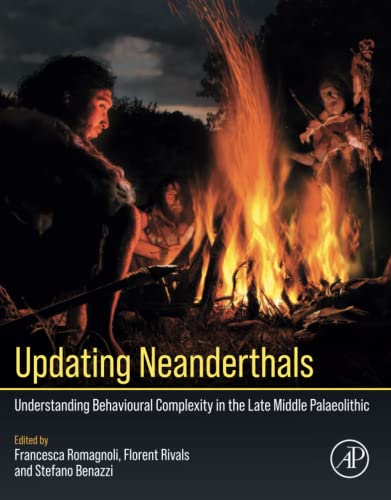Updating Neanderthals Understanding Behavioural Complexity in the Late Middle Palaeolithic 1st Edition by Francesca Romagnoli, Florent Rivals, Stefano Benazzi 0128214295 978012821429
$50.00 Original price was: $50.00.$25.00Current price is: $25.00.
Updating Neanderthals Understanding Behavioural Complexity in the Late Middle Palaeolithic 1st Edition by Francesca Romagnoli, Florent Rivals, Stefano Benazzi – Ebook PDF Instant Download/Delivery: 0128214295, 978012821429
Full download Updating Neanderthals Understanding Behavioural Complexity in the Late Middle Palaeolithic 1st Edition after payment

Product details:
ISBN 10: 0128214295
ISBN 13: 978012821429
Author: Francesca Romagnoli, Florent Rivals, Stefano Benazzi
Updating Neanderthals: Understanding Behavioral Complexity in the Late Middle Paleolithic provides comprehensive knowledge on Neanderthals who lived throughout the European and Asian continents. The book synthesizes historical information about the study of Middle Paleolithic populations and presents current debates about their genetics, subsistence, technology, social and cognitive behaviors. It focuses on the last phase of Neanderthal settlements and presents the main patterns of modern humans across Europe. Written by international experts on the Middle Paleolithic who have conducted innovative studies in the last three decades, this book explores the implications of interactions between different human species, including Neanderthals, Denisovans and Sapiens.
In addition, the book discusses the diversity and variability of human adaptations and behaviors in the changing climate and environment of the Late Pleistocene, and the relationship between these behaviors, demography and cognitive capabilities.
- Offers a comprehensive update on the variability and diversity of Neanderthal behaviors during the Late Pleistocene
- Presents an interdisciplinary reconstruction of Neanderthals by assessing archaeology, paleontology, paleoecology, anthropology, genetics and cognition
- Reviews the reliability of archaeological data and the theoretical and methodological advances of the last 30 years
- Discusses the most debated Neanderthal themes, such as demography, diet, socio-economy and art
Updating Neanderthals Understanding Behavioural Complexity in the Late Middle Palaeolithic 1st Table of contents:
Chapter 1: Updating Neanderthals: Taking stock of more than 160 years of studies
Abstract
Acknowledgements
1: Discovery, first studies, and the illustration of the dumb ape
2: The main scientific debates between 1930 and 1980: Anthropological and cultural data
3: The end of the 20th century
4: The 21st century: Updating Neanderthals
5: From brutality to rehabilitation and narration
References
Chapter 2: The climatic and environmental context of the Late Pleistocene
Abstract
Acknowledgements
1: Introduction
2: Orbital and abrupt climate changes through the Late Pleistocene
3: Vegetation response to Late Pleistocene climate changes
4: How did Neanderthals cope with climate changes?
5: Final remarks
References
Chapter 3: Diet and ecological interactions in the Middle and Late Pleistocene
Abstract
Acknowledgements
1: Introduction
2: Dietary ecology of animals and Neanderthals
3: Complex interactions between Neanderthals and animals
4: Final remarks
References
Chapter 4: Different species on the horizon: The Denisova hominins
Abstract
1: Denisova cave and the Altai (overview)
2: Denisovan fossils from Denisova cave
3: Xiahe
4: Denisovan genetics
5: Other Denisovans?
6: Final remarks
References
Chapter 5: Neanderthals: Anatomy, genes, and evolution
Abstract
Acknowledgements
1: Introduction
2: What are Neanderthal traits?
3: Two explanatory evolutionary models
4: Evolutionary anatomy of the Neanderthal phenotype
5: Evolutionary morphology of Neanderthal characters
6: Phase 1. Origin of H. heidelbergensis (s.s.)
7: Phase 2. Origin of H. neanderthalensis
8: Final remarks
References
Chapter 6: The Neanderthal brain: Biological and cognitive evolution
Abstract
1: How to investigate a palaeo-brain: Tools and methods
2: The molecular basis of brain evolution in Neanderthal and H. sapiens: DNA and RNA (genes, polymorphisms, and noncoding, regulatory elements)
3: Not only technology: The graphical record of the Neanderthals as a window on their cognitive traits
4: Cognitive studies and archaeological evidence for the creation of meaning
5: Final remarks
References
Chapter 7: Selection versus opportunism: A view from Neanderthal subsistence strategies
Abstract
Acknowledgements
1: Introduction
2: Selection at a regional scale
3: Selection at a local scale
4: The hunter’s choice
5: Selection within animal carcasses
6: Diversification of the diet and the exploitation of nonungulate animals
7: Final remarks
References
Chapter 8: Small animal use by Neanderthals
Abstract
Acknowledgements
1: Introduction
2: Rabbits and hares
3: Birds
4: Tortoises
5: Aquatic resources
6: Final remarks
Author contributions
References
Chapter 9: The use of plants by Neanderthals as food, medicine, and raw materials
Abstract
1: Introduction
2: Methods used in recovery of evidence for plant use
3: Archaeological evidence for plants
4: Behavioural implications of the plant evidence
5: Final remarks
References
Chapter 10: Neanderthal technological variability: A wide-ranging geographical perspective on the final Middle Palaeolithic
Abstract
Acknowledgements
1: The ‘Mousterian debate’ today
2: Concepts and abbreviations
3: The Levant
4: The eastern regions: From the Altai to Eastern Europe
5: Central Europe
6: North-western Europe and southern France
7: Mediterranean Europe
8: Neanderthal variability
9: Final remarks
References
Chapter 11: The organisation of living spaces in Neanderthal campsites
Abstract
Acknowledgement
1: Introduction
2: Constructing the paradigm: What does a hunter–gatherer camp look like?
3: Ethnographic concepts, archaeological facts
4: Spatial units in Middle Palaeolithic sites
5: Beyond activity areas: Time uncertainties in campsite layout
6: Final remarks
References
Chapter 12: Fire among Neanderthals
Abstract
Acknowledgements
1: Introduction
2: Background to research on European Middle Palaeolithic fire: History, archaeological evidence, and debates
3: Methods and techniques
4: Fire among Neanderthals
5: Final remarks
Author contributions
References
Chapter 13: ‘Art’: Neanderthal symbolic graphic behaviour
Abstract
1: Portable graphic symbolism
2: Parietal graphic symbolism
3: Cognitive implications
4: Final remarks
References
Chapter 14: Spiritual and symbolic activities of Neanderthals
Abstract
Acknowledgements
1: Introduction
2: Neanderthal funerary activities
3: Marine shells and pigment use
4: Wings and feathers
5: Raptor claws
6: Non-utilitarian objects, curiosa
7: Appropriation of the darkness of the underground world
8: Final remarks
References
Chapter 15: Beyond European boundaries: Neanderthals in the Armenian Highlands and the Caucasus
Abstract
Acknowledgements
1: Eco-geography and Pleistocene palaeoenvironment of the Armenian Highlands and the Caucasus
2: Middle Palaeolithic sites in the Armenian Highlands and the Caucasus. Site types, chronology, and distribution
3: Middle Palaeolithic technological concepts, traditions or cultural features, and the regional sequence
4: Middle Palaeolithic technological organisation, land use, and regional artefact discard patterns
5: Middle Palaeolithic hunter–gatherer subsistence and hunting strategies and use of fire
6: Art and symbolic behaviour? Modified cave bear bones and teeth from Middle Palaeolithic deposits in the Armenian Highlands and the Caucasus
7: The problem of replacement of Neanderthals by Homo sapiens in the study area
8: Final remarks
References
Chapter 16: Methodological advances in Neanderthal identification, phylogeny, chronology, mobility, climate, and diet
Abstract
1: Introduction
2: Neanderthals and their contemporaries
3: The radiocarbon dating and the last Neanderthal. Present status quo
4: Reconstructing Neanderthal’s way of life (diet, habitat, weaning, mobility)
5: Final remarks
References
Chapter 17: The arrival of Homo sapiens in the Near East and Europe
Abstract
Acknowledgements
1: Introduction
2: The Initial Upper Palaeolithic (IUP)
3: The Early Upper Palaeolithic (EUP)
4: The transitional industries
5: Final remarks
References
Afterword—From a homogeneous population to a great diversity: Discussing perspectives on Middle Palaeolithic studies for the coming years
Index
People also search for Updating Neanderthals Understanding Behavioural Complexity in the Late Middle Palaeolithic 1st:
updating neanderthals
deep homology and the origins of evolutionary novelty
evolution of biological complexity
neanderthals behavior
Tags:
Francesca Romagnoli,Florent Rivals,Stefano Benazzi,Updating Neanderthals,Understanding Behavioural Complexity
You may also like…
History Middle Ages
Uncategorized
History - Archaeology
History - Archaeology
Palaeolithic and Mesolithic Sailors in the Aegean and the Near East 1st Edition Adamantios Sampson
Psychology - Cognitive Psychology
The Therapeutic Relationship in Cognitive Behavioural Therapy 1st Edition Stirling Moorey
& Scottish Poetry











